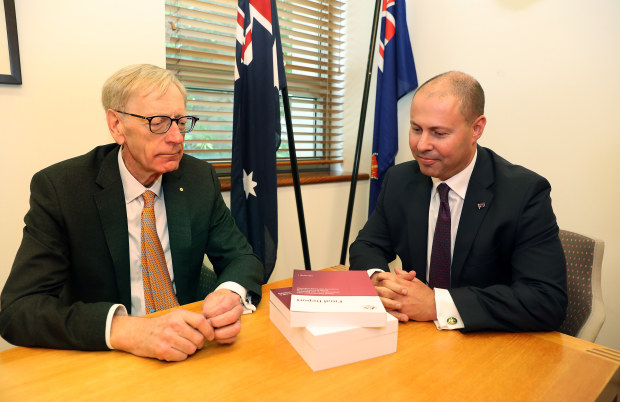Inside the unstoppable rise of the country’s mortgage brokers

Based on the standard broker commission rates, this suggests the average income of mortgage brokers in the Top 100 is close to $2 million, and that the top mortgage brokerage operations are earning between $5 million and $6 million.
It is little wonder that one of the early pioneers of the mortgage broking industry – John Symond, who launched Aussie Home Loans in the early 1990s – owns one of the country’s most valuable pieces of real estate. His Point Piper home, Wingadal, recently hit the market with a price tag of more than $200 million.

John Symond in 1995, when he was shaking up banking competition. David Hancock
Needless to say, the billions of dollars flowing to the mortgage broking industry each year is playing havoc with the profits of the country’s big banks. The major banks’ net interest margins – the difference between what a bank makes from lending and what it pays for funding – have dropped from roughly 3.5 per cent in 2000 to less than 2 per cent, largely reflecting the vicious price competition in the mortgage market.
At their latest profit results, executives from some of the country’s biggest banks signalled they were losing patience with writing loans through the mortgage brokers that failed to cover the banks’ cost of capital. “I think no company would, in perpetuity, sell goods and services at a loss,” Andrew Irvine, National Australia Bank’s new chief executive, observed earlier this month.
At the same time, Westpac’s retail bank boss Jason Yetton vowed to achieve the “right returns for shareholders” rather than discounting loans to boost the bank’s market share, while Macquarie’s retail banking boss Greg Ward noted it aimed to be “disciplined on returns, rather than chasing market share”.
But for all bankers’ lofty promises to eschew discounted loans, it’s clear that the balance of power has shifted decisively towards the mortgage brokers.
A McKinsey report published in November pointed out that banks’ home lending soared during the COVID-19 pandemic when interest rates fell close to zero, but slowed abruptly as rising rates and a cost-of-living crisis caused mortgage applications to drop, leaving banks fighting over a shrinking pool of new home loans.
“One of the winners in the turbulent mortgage climate has been the mortgage broker,” the report observed.
“In many major markets, mortgage brokers originate a surprising portion of home loans: in the Netherlands, for example, brokers originate around 60 per cent of all home loans; in Australia, that proportion hovers around 70 per cent; and in the United Kingdom, it climbs as high as 75 per cent.”
The report warned that “incumbent banks are losing ground against these new market forces and face increased risk of their mortgage product becoming commoditised”.
So how are banks fighting back? According to McKinsey, some have dropped home loan rates to bolster mortgage application volumes, while others are “offering significant incentives to customers and intermediaries to win business.”
And, it adds, “some are taking on brokers directly by launching new digital attackers that market directly to customers and bypass the broker market”.
For instance, McKinsey pointed to the Commonwealth Bank’s launch of Unloan “as a direct digital-only refinancing business targeting price-conscious homeowners with a digital application”.
But while bankers may dream of a future in which customers bypass the mortgage brokers and choose direct digital-only mortgages from the banks, they’re realistic enough to know this will be a slow burn.
In the meantime, senior bankers have to contend with the additional irritation that successful mortgage brokers are pocketing much more money than the banks’ own top home lenders, who earn between $300,000 and $350,000 a year. As a result, bank bosses have to watch a steady exodus of their more ambitious and entrepreneurial staff to the mortgage broking industry.

Anja Panneck is the chief executive of the Mortgage and Finance Association of Australia. Oscar Colman
But do mortgage brokers actually deliver value for money?
“Consumers are voting with their feet”, says Anja Pannek, chief executive of the Mortgage Finance Association of Australia, the peak national body for the mortgage and finance broking industry. “Close to 72 per cent of Australians chose to use a mortgage broker. That’s up 12 or 13 percentage points since the mortgage brokers’ best interest duty was introduced after the [Hayne] royal commission.”
Pannek argues that consumers get better choice, competition and consumer protection by using a mortgage broker rather than dealing directly with a bank.
“Because mortgage brokers have access to between 30 and 60 lenders, they can drive a really good deal on the consumer’s behalf, whether they’re a new borrower, or refinancing a loan, or discharging a loan”, she says. “And brokers don’t charge their clients a fee because the lender reimburses the broker.”
Pannek points out that mortgage brokers “also help their clients with financial literacy, budgeting and navigating the whole home loan process, which is pretty complex”.
Typically, mortgage brokers receive an upfront commission of between 0.55 per cent to 0.7 per cent of the size of the loan, as well as trail commissions which are usually between 0.165 per cent and 0.275 per cent of the remaining loan balance each year
The final report of the Hayne royal commission, released in February 2019, zeroed in on the conflicted nature of mortgage broker remuneration. Because the lender pays the broker’s commission, this is likely to sway the broker’s recommendations about which lender they should choose and how much they should borrow. At the same time, the borrower expects undivided loyalty from their mortgage broker.
The final report recommended changing the structure so that the borrower, rather than the lender, paid the broker. And it was particularly critical of trail commissions, which it recommended should be prohibited within a period of 12 to 18 months.
“Why should a broker, whose work is complete when the loan is arranged, continue to benefit from the loan for years to come?” it queried.
In the first flurry of post-royal commission enthusiasm, the Morrison government embraced this idea of completely overhauling broker remuneration, beginning with a prohibition on trail commissions, and then extending to a wider prohibition on lenders paying other commissions to brokers.
Instead, the borrower, not the lender, would pay the mortgage broker a fee for providing help in securing a home loan.
But the Coalition was forced into an embarrassing backflip following an intense lobbying campaign by the mortgage broking industry – which has long been a major political backer.
The campaign was spearheaded by Morrison’s celebrity friend, Mark Bouris, whose financial advice firm Yellow Brick Road was at that time collecting $53 million annually in trail commissions.
Bouris personally lobbied Morrison, the then prime minister, and then treasurer Josh Frydenberg to reverse the government’s pledge to adopt Hayne’s recommendation.

Kenneth Hayne delivering his royal commission final report to then treasurer Josh Frydenberg in February 2019. AAP
Mortgage brokers were able to convince the government that banning trail commissions would be detrimental to consumers because it would reduce competition in the mortgage market. That’s because smaller lenders, with fewer branches, rely on mortgage brokers to help them compete with the big banks and their extensive branch networks.
The government did adopt the Hayne royal commission’s recommendation to impose a new legal obligation on brokers to act in the best interests of borrowers.
And Frydenberg pledged that in three years’ time, both upfront and trailing commissions would be reviewed by regulators. But when 2022 rolled around, the government decided to dump the proposed review of broker remuneration, claiming there was no systemic evidence of broker misconduct or consumer detriment stemming from the broker remuneration structure.
MFAA’s Pannek argues “trail commissions for brokers are often misunderstood”. “When a broker originates a loan for a lender, they originate future value, future [net interest margin],” she says. “The way that the lender compensates a broker is to pay a component of the future value upfront, and the remainder is paid as a trail. That’s the structure of broker remuneration, and it helps the broker run their business on an ongoing basis.”
She also points out that “if that loan is discharged – generally within 18 months to two years – then all of the broker’s remuneration is clawed back, so they don’t earn a cent”.
Pannek also points out that “46 per cent of brokers are single operators. They have to pay for all the costs of running a business.”
Warren Wang, the founder and director of Sydney-based Reservoir Finance, points out that “our commission is based on the size of the loan, but that doesn’t always benefit brokers”.
“Very recently, we did a home loan for $110,000, and for such a small amount we don’t charge, and therefore we may end up earning nearly nothing after all costs,” he says, adding that “many brokers don’t do tiny loans because that means they’ll only earn a tiny commission. But we’re happy to do that.”
According to Wang: “I think most mortgage brokers want to help their clients. If you’re just doing this for the purpose of chasing money, I don’t think you will survive in this industry for a long time. After the royal commission, there were more compliance requirements and more lender requirements. You need to be diligent in this industry.
“When I talk to the big brokers, they love what they’re doing. They’re not doing it for the money. But money is a good reward for mortgage brokers if they’re doing well,” he says.
Source link





